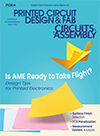News
News
The Dangers of ‘Tweaking Out’
Published: 02 March 2007
by Chrys Shea
The Pb-free transition underscores the need for process control.
At one point in my career, I was a process engineer with an assembler that had been operating for more than 20 years, and had implemented surface mount technology about seven years prior to my arrival. My job was to update the SMT assembly processes and raise yields. When assessing the situation, I found that regular maintenance and calibration were not part of the standard operating procedure. In fact, these two critical elements were almost completely ignored. Machines were attended to only when they broke down, and misplacements were addressed through programming tweaks. Although this scenario may seem incredibly scary to champions of process control, it is not uncommon in today’s world of eroding margins and needs for high uptime and throughput.
Having been enlightened to the power of process control at my previous job, I immediately set out to address the equipment situation before any attempts at process improvement were made. Reason: With process variation amounts unknown, it would have been nearly impossible to accurately gauge the impact of any changes.
So we invested time and money to perform preventive maintenance on all the placement equipment; we calibrated every system and subsystem that could be calibrated, and we took measurements. The equipment showed excellent Cpk’s after calibration. We had a solid baseline and were on the right track to running a stable process. The only problem: Yields got worse! There were more out-of-spec placements than ever before.
As I investigated, I found that the de facto SOP was to tweak placement coordinates to compensate for machine drift over time. When new products hit the line, programs were generated from CAD data and automatically tweaked as part of the NPI process. These “minor adjustments” had become such normal procedures throughout the operation that no one considered the recurring need for corrections as an indication of a problem. The net result was that there was absolutely no semblance of original CAD coordinates left anywhere in any of the placement programs.
When we calibrated the machines, we brought them back to zero, but all our placement programs were so “tweaked out” with compensation factors that the calibration effort actually made things worse. More than 400 assembly part numbers and programs were affected.
This was a fine mess. We couldn’t “uncalibrate” the machines, and that would be the wrong thing to do anyway. It was the point of no return. We had to forge ahead and begin regenerating placement programs. The effort took a lot more resources than originally planned, but it was a necessary evil and had to be done if progress were to be realized.
This occurred years ago, in the relatively forgiving world of SnPb soldering. At the time I encountered this dilemma, I thought things could not possibly get worse. Reflecting on the circumstances, I cannot imagine the train wreck had these uncontrolled conditions been combined with a Pb-free transition. No doubt, in the scenario just described, many bad placements regularly went unnoticed and were rectified by natural self-centering of SnPb in the reflow oven. We cannot count on that with Pb-free solders. I’m also fairly confident that tombstoning rates would have soared, as placement offsets are documented to be one of the largest factors affecting this defect mode, and Pb-free solders seem to exacerbate the issue.
I learned some important lessons back in the 1990s:
1. Maintain CAD data for placement machines. If something is placing out-of-spec, investigate the root cause. Do not slap on a bandage and return to production as usual. Not only is a tweak a temporary fix, it masks a systemic problem and actually buries it deeper into the system.
2. Regularly scheduled maintenance and calibration is a small upfront investment with an enormous long-term payback. Short, well-spaced intervals of downtime cost less money in the long run than the major overhauls that will ultimately result from inattention or indifference to recommended periodic checks.
3. Consider and anticipate potential side effects of major process changes before making them. Had I understood the degree to which the calibration efforts would affect production, I could have better planned, communicated and prepared for the rocky road ahead of me.
These lessons apply to any SMT assembly process at any given time, but are even more pertinent today as we continue the major transition to Pb-free processing. They bring to mind two popular clichés: Experience is the best teacher, and hindsight is 20/20. My sincere hope is that at least some Circuits Assembly readers learn from my painful experience and avoid their own.
The bottom line. Regardless of alloy, get your placement machines under control! An astounding number of operations lack diligent machine maintenance and calibration. The Pb-free transition brings many issues as a matter of course, plenty to keep an engineer busy all day long. The addition of unanticipated remedial projects on top of the pile of transition issues is not a desirable situation, and can be avoided completely with a little upfront work.
Chrys Shea is a R&D applications engineering manager at Cookson Electronics (cooksonelectronics.com); chrysshea@cooksonelectronics.com. Her column appears monthly.
Press Releases
- Libra Industries Expands Precision Fabrication Capabilities in Guaymas with Advanced Amada Laser System
- Distron Adds Second Juki Selective Soldering System to Support Growing Production Demand
- Amtech’s New Process Upgrades Elevate Transparency, Speed, and Manufacturing Readiness
- FlashPCB Enhances SMT Production Line with Heller 1809 Reflow Oven and KIC ProBot







